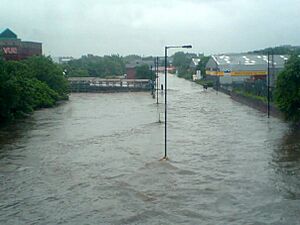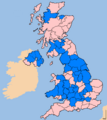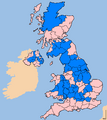2007 United Kingdom floods facts for kids

Severn flood 2007 Interview with ITN
|
|
| Meteorological history | |
|---|---|
| Duration | 1 June 2007 – 28 July 2007 |
| Overall effects | |
| Fatalities | 13 |
| Damage | about £6.5 billion |
| Areas affected | (see below) |
During the summer of 2007, large floods hit many parts of the United Kingdom. The worst flooding happened in different areas at different times. For example, on June 14, Northern Ireland and Scotland were affected. On June 15, it was East Yorkshire and the Midlands. Later, on June 25, Yorkshire, the Midlands, and parts of the West Country were hit. Finally, on July 28, more areas in the West Country, Oxfordshire, Berkshire, and South Wales experienced severe flooding.
June 2007 was one of the wettest months ever recorded in the UK. The country received more than double its usual rainfall for June. Some places got a whole month's rain in just 24 hours! The period from May to July 2007 was the wettest since records began in 1776. July also had very unsettled weather with lots of rain, especially on July 20, when over 120 mm (4.7 inches) of rain fell in southern England.
The rescue efforts by civil and military groups in June and July were the biggest in the UK during peacetime. The Environment Agency said the July floods were very serious and even worse than the famous floods of 1947.
Contents
What Caused the Floods?

June 2007 started with calm, dry weather. But around June 10, the weather changed. A weather system called an "upper trough" moved in, causing thunderstorms and flooding in Northern Ireland on June 12.
Later that week, a slow-moving area of low pressure brought more rain. This system moved across the British Isles, causing very heavy rainfall, especially on June 15. Many places broke their rainfall records, leading to local floods. Even after this system weakened, the air remained unstable, bringing more heavy showers and thunderstorms. This made it hard for the ground to dry out.
On June 25, another strong low-pressure system, named Cyclone Uriah, moved over England. It dropped over 100 mm (3.9 inches) of rain in some areas. Because the ground was already very wet from earlier rains, this led to widespread flooding. The Midlands, Gloucestershire, Worcestershire, and parts of Yorkshire were hit hardest. Strong winds also caused damage along the east coast. For example, RAF Fylingdales reported 103 mm (4.1 inches) of rain in 24 hours.
The Met Office (UK's weather service) warned about more severe weather for the weekend of July 20. They predicted 20 to 50 mm (0.8 to 2 inches) of rain, which could cause more flooding in areas already waterlogged.
On July 20, a strong weather system moved across Southern England. Many places received a month's worth of rain in just one day. For instance, RAF Brize Norton in Oxfordshire recorded 126.6 mm (5 inches) of rain, which is about a sixth of its yearly total! This led to 16 severe flood warnings from the Environment Agency. By July 21, many towns and villages were flooded, especially in Gloucestershire, Worcestershire, and South Wales.
Some scientists think this unusual weather might be linked to La Nina in the Pacific Ocean and the jet stream (a fast-moving air current) being further south than usual.
Areas Affected by the Floods
England was badly hit by the floods in both June and July. The north of England was severely affected in June, while the west was hit hard in July. July 2007 was England's wettest July ever recorded. Gloucestershire was the county that suffered the most.
Flooding in England
Berkshire Floods
On July 20, the M4 motorway had to close because of a landslide caused by flooding. About 1,100 homes in Thatcham were affected by sudden floods. Towns like Newbury and Maidenhead also saw their town centres flooded. The River Thames and other rivers were expected to overflow. Trinity School was badly damaged when a nearby ornamental lake overflowed.
The floods even affected the Atomic Weapons Establishment at Burghfield, which handles nuclear warheads. Work there was stopped for almost a year.
Gloucestershire Floods
On July 19, the fire service in Gloucestershire received 1,800 calls in just two days, compared to their usual 8,000 calls in a whole year.
On July 22, the football stadium for Gloucester City A.F.C. was flooded. Tewkesbury was completely cut off by water, with some parts of the town under about 1 meter (3 feet) of water. Water even entered Tewkesbury Abbey for the first time in 247 years. The Mythe Water Treatment Works, which cleans water for the area, was also flooded. This meant that treated water would run out for Tewkesbury, Cheltenham, Gloucester, and nearby areas.
Emergency services, including the military, worked hard to protect the Walham electricity substation in Gloucester, which supplied power to half a million people. While Walham was saved, another substation in Castle Meads had to be turned off, leaving 50,000 homes without electricity.
By July 24, about 420,000 people had no running water. The Army helped distribute three million bottles of water a day, and even brewing companies offered their beer tankers to help carry drinking water. It took 16 days for tap water to be safe to drink again in the affected homes.
Sadly, some people died during the floods in Tewkesbury. A man and his son died from carbon monoxide poisoning while trying to stop flooding in a cellar. Another young man's body was found after he had been missing for a week.
East Riding of Yorkshire and Hull Floods
On June 15, this region was hit by floods. Roads and schools in Hull were closed. Police declared a major incident. Hessle suffered severe flooding mixed with sewage.
On June 25, the region was flooded again. Fire crews received over 1,500 calls in 12 hours. Dozens of homes in Beverley were evacuated, and about 90 people were rescued by boats from 1 meter (4 feet) of floodwater in Hull. A 28-year-old man died in Hessle after getting trapped in a drain. The new Hull police station also had to be emptied due to flooding. The next day, only 12 out of 88 schools in Hull were open, affecting 30,000 children.
By July 5, an estimated 35,000 people in 17,000 homes in Hull had been affected by flooding. Over 10,000 homes had to be evacuated. Hull City Council estimated the repair costs at £200 million. By September 3, the number of flooded houses was revised to 7,800, with 1,300 businesses also affected.
South Yorkshire Floods

On June 25, Sheffield suffered huge damage when the River Don overflowed. This caused widespread flooding in the Don Valley area. A 14-year-old boy was swept away by the swollen River Sheaf, and a 68-year-old man died trying to cross a flooded road. The Meadowhall shopping centre was closed due to flooding, and Sheffield Wednesday's stadium, Hillsborough, was under 1.83 meters (6 feet) of water. The RAF used helicopters to rescue people from buildings. There was also widespread flooding in Barnsley, Doncaster, and Rotherham.
By June 26, the water in some parts of Sheffield went down. However, over 700 villagers from Catcliffe, near Rotherham's Ulley reservoir, were evacuated because cracks appeared in the dam. Emergency services pumped millions of gallons of water from the reservoir to reduce pressure on the damaged dam. The nearby M1 Motorway was closed as a safety measure.
On June 27, the Army moved into the Doncaster area after the River Don overflowed again.
Flooding in Wales
Wales also experienced floods in June and July, with the eastern areas being the most affected. June 2007 was Wales's wettest June since 1998.
Powys Floods
In Montgomeryshire, ten people were rescued in Tregynon, and a dozen homes were flooded in Bettws Cedewain on July 22. Firefighters used a boat to evacuate people from homes and cars cut off by floods near Welshpool. In Radnorshire, 30 tonnes of earth and debris blocked the only road out of Barland. In Brecknockshire, the River Wye overflowed in Builth Wells on July 1. The very wet ground later caused problems at the Royal Welsh Show on July 24.
Flooding in Northern Ireland
Northern Ireland was also hit by floods in June and July. It was Northern Ireland's wettest June since 1958.
County Antrim Floods
On June 12, parts of East Belfast were affected, including the Kings Road and the Parliament Buildings in Stormont. Eighty residents were evacuated from an old people's home. On July 2, houses were flooded in Cushendall after the River Dall overflowed. On July 16, parts of Belfast International Airport were flooded by a sudden thunderstorm, meaning 10 planes could not land. Landslides closed the Antrim Coast Road, and people were trapped in their cars in Portrush.
Flooding in Scotland
Scotland experienced floods in June and July, with the Scottish Lowlands being the most affected. On June 12, the Met Office issued warnings for heavy rain in Scotland. It was Scotland's wettest June since 1938.
Ayrshire and Arran Floods
On June 21, about 2,000 homes lost electricity, and properties were affected as sudden floods hit Kilmarnock. On July 18, Kilmarnock was flooded again, the River Irvine overflowed in Newmilns, and sudden floods affected roads, including the M77 motorway.
Timeline of the Floods
Here's a quick look at when different areas were affected by the floods:
- June 1–7: England (Buckinghamshire)
- June 8–14: England (Lancashire), Northern Ireland (Belfast, Lisburn, Omagh), Wales (Ceredigion)
- June 15–21: England (County Durham, Herefordshire, Yorkshire, Shropshire, Worcestershire), Northern Ireland (Bangor, Newtownards), Scotland (Ayrshire, Lanarkshire), Wales (Ceredigion)
- June 22–28: England (East Riding of Yorkshire, Hull, Nottinghamshire, Shropshire, Worcestershire, South Yorkshire), Scotland (Peebles), Wales (Denbighshire, Flintshire, Monmouthshire, Wrexham)
- June 29 – July 5: England (Buckinghamshire, Lancashire, West Yorkshire), Northern Ireland (Antrim), Scotland (Midlothian, Moray)
- July 6–12: A quiet period between the main June and July floods.
- July 13–19: England (County Durham, Cumbria, Lancashire, North Yorkshire, Worcestershire), Northern Ireland (Coleraine, Larne), Scotland (Ayrshire, Dumfriesshire, Ross and Cromarty), Wales (Denbighshire)
- July 20–26: England (Bedfordshire, Berkshire, Buckinghamshire, Cambridgeshire, Gloucestershire, Greater London, Herefordshire, Lincolnshire, Oxfordshire, Warwickshire, Wiltshire, Worcestershire), Wales (Newport, Monmouthshire, Powys, Torfaen, Vale of Glamorgan)
After the Floods
Rescue Efforts
After the floods in late June, the rescue effort was called the "biggest in peacetime Britain" by the Fire Brigades Union. In July, the RAF said it was carrying out its largest ever peacetime rescue operation. Six Sea King helicopters rescued up to 120 people. An RAF Chinook helicopter also helped by moving materials to strengthen the banks of the River Don. The Environment Agency called the situation "critical."
Volunteer groups like 4x4 Response helped councils and emergency services. During the recovery, some responders helped the Red Cross give out fresh drinking water in Gloucestershire after the main water supply was contaminated.
Health and Safety
The Health Protection Agency advised people to avoid touching flood water directly, but said the risk of getting sick was low. No outbreaks of illness were reported. In some areas, bottled water was given out when sewage works were flooded.
Damage to Crops
The floods caused widespread damage to crops, especially vegetables like broccoli, carrots, peas, and potatoes. In parts of Lincolnshire, it was thought that 40% of the pea crop might have been destroyed. Prices of vegetables were expected to go up in the following months.
Cost of the Floods
Baroness Young, chief executive of the Environment Agency, said that about £1 billion a year was needed to improve flood defences. The Association of British Insurers estimated the total cost of the June and July floods to be £3 billion.
A report by the Environment Agency in 2010 said that the 2007 floods were so big and serious that they should be called a "national disaster." The total cost of the floods was estimated to be about £3.2 billion in 2007 prices.
Images for kids
-
Cyclone Uriah crossing the United Kingdom on 25 June. Associated heavy rainfall led to flooding across northern England, particularly in Sheffield.
-
Non-administrative counties in England affected in June and July 2007 floods as of 24 July (marked in blue)
-
Administrative counties in England affected in June and July 2007 floods as of 24 July (marked in blue)
-
A flooded Pizza Hut in Chesterfield
-
Rising River Severn at Ironbridge, Shropshire, 28 June
-
Bridge collapse in Ludlow, 26 June
-
A road near the Meadowhall shopping centre showing extensive flooding after the River Don burst its banks
-
Non-administrative counties in Wales affected in June and July 2007 floods as of 24 July (marked in blue)
-
Principal areas in Wales affected in June and July 2007 floods as of 24 July (marked in blue)
-
Non-administrative counties in Northern Ireland affected in June and July 2007 floods as of 24 July (marked in blue)
-
Districts in Northern Ireland affected in June and July 2007 floods as of 24 July (marked in blue)
-
Council areas in Scotland affected in June and July 2007 floods as of 24 July (marked in blue)
See also
 In Spanish: Inundaciones en el Reino Unido de 2007 para niños
In Spanish: Inundaciones en el Reino Unido de 2007 para niños
- List of natural disasters in Britain and Ireland
- 2009 Great Britain and Ireland floods
- Great Sheffield Flood
- Flood risk assessment



































